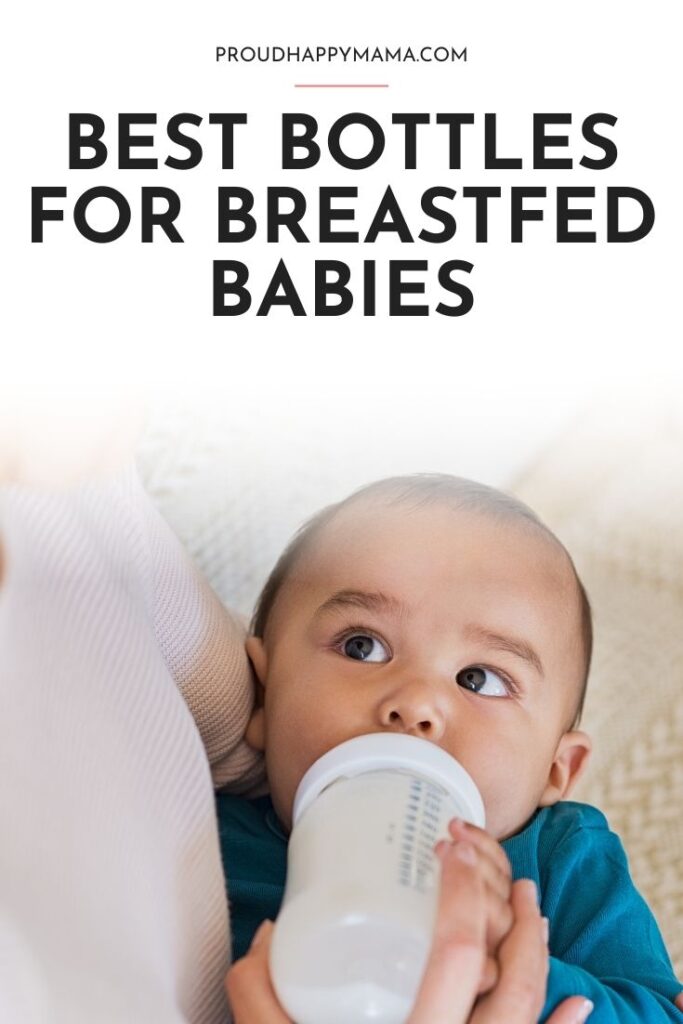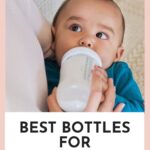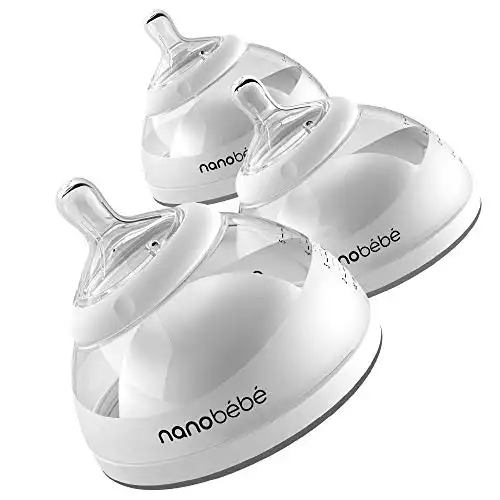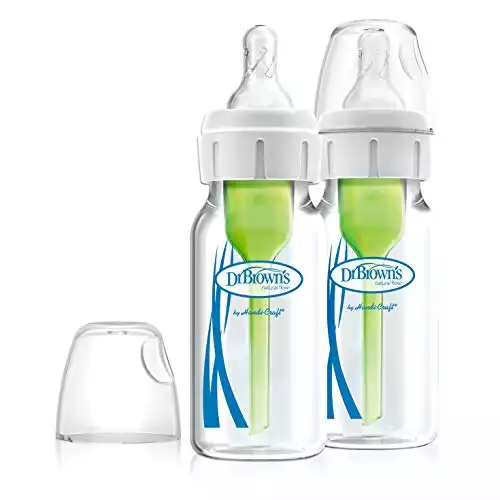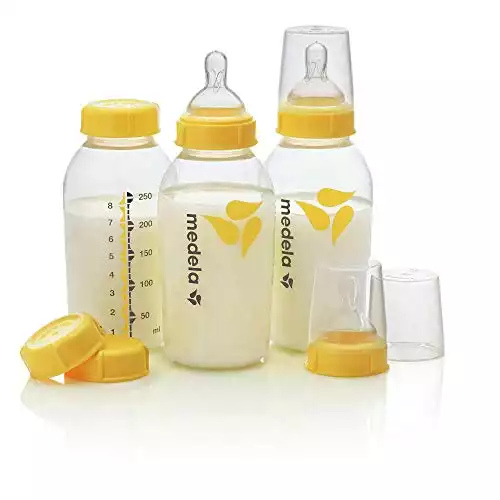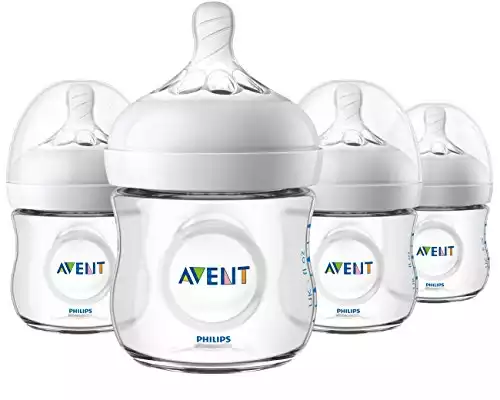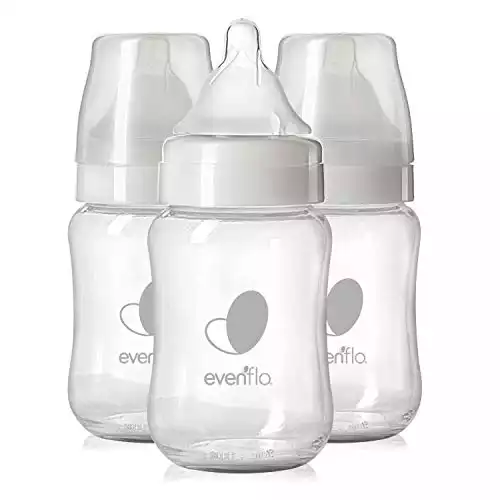Best Bottles For Breastfed Babies
Looking for the best bottles for breastfed babies?
Then let us help with our guide to the best bottles for breastfeeding!
Transitioning your baby onto a bottle is not always easy as some people may think, especially if you have been breastfeeding for a while.
As we’ll discuss in more detail below, you can face several barriers such as your bottles not connecting to your breast pump, your baby refusing the bottle, discomfort in your baby due to excess gas, and the bottles limited capacity to store breastmilk.
But the good news, we’ve done the hard work for you and put together this list of the best bottle to use while breastfeeding.
And if you love this guide to bottles for breastfeeding babies, make sure you check out these guides on Lansinoh Breast Pump reviews, how to power pump with Spectra S2, and best pumping bras for Spectra. Or even this guide on how to warm bottles on the go!
This post contains affiliate links. See our full disclosure here
This award winning baby bottle for breastfed babies encourage a smooth transition from breast to bottle (and back).
And with it’s 2x faster cooling capabilities to reduce bacterial growth to its included breast pump adaptor to its slow flow 360 degree double vented system to prevent colic and baby gas, it’s no wonder that this is our top pick when it comes to breastfeeding bottles!
List of 5 Best Bottles For Breastfed Babies
Best Bottles For Breastfeeding
Below are our top rated bottles for breastfed babies:
1. Dr. Brown’s Natural Flow Narrow Glass Baby Bottles
These bottles have so many benefits for your baby, there are easy to latch onto due to their narrow neck, they have an internal ventilation system that prevents the baby from ingesting air bubbles, and is clinically proven to reduce colic.
The bottles also reduce spit-up, gas, and burping by eliminating the vacuum effect that causes these.
You can remove the ventilation system as your baby gets older and you feel like it is no longer necessary so that you don’t have to go through the hassle of introducing them to another bottle.
The way in which a baby latches onto a bottle is arguably one of the most important things when considering what bottle to buy, Dr. Brown’s Natural Flow Option+ bottles make this transition from nipple to bottle because they have narrow necks which makes it a lot easier for the baby to latch on as bottles with wide necks have a base that is too wide for a lot of babies.
The nipple on these bottles are made out of soft silicone and are specially engineered to offer a natural, consistent flow so your baby is not caught off guard and can relax as they enjoy their milk.
The bottles are made out of thick pharmaceutical-grade borosilicate glass that is resistant to heat and shock.
Though it depends on what breast pump you have, the narrow neck of these bottles should be compatible with most pumps and can attach directly.
They are also dishwasher safe which saves a lot of time in the evenings for you to sit down and unwind with a happy, full baby.
You may also like our review on Avent vs Dr Brown bottles!
Pros:
- Ventilation system – this helps reduce colic and gas problems, can be removed when baby gets older, so you don’t have to buy a new bottle
- Thick glass – the bottles are made from shock and heat resistant glass which you can wash in the dishwasher and keep for much longer than you can keep plastic bottles
- Steady flow – the nipples allow a steady, even flow of milk which makes it feel more natural for the baby
Cons:
- Heavy – the glass that the bottles are made from make them a bit heavy and can be hard for younger babies to hold without assistance
2. Medela Breast Milk Storage Bottles
If you are more focused on cutting down the time spent on pumping, transferring milk, and cleaning parts then these Medela Breast Milk Storage Bottles will be what you are looking for.
To get the most out of these bottles, make sure that you are using a Medela breast pump as well as the bottles can attach directly onto the pump which allows you to pump, store and feed all with the same bottle.
The bottles are made without BPA (bisphenol A) which is a chemical that certain plastics are made from and research has found it can cause health issues such as high blood pressure, cardiovascular disease, and type 2 diabetes, so it’s definitely not a chemical you want in the plastic of your baby’s bottles.
Instead, the plastic that these bottles are made from is safe and designed to retain the beneficial properties of breast milk and can be stored long-term.
The screw-on lids are leakproof and come with three each of bottles, nipples that are wide-based and have medium flow, collars, solid caps and lids, and a micro-steam bag that lets you disinfect the bottles and accessories daily.
Additionally, you can choose between five-ounce or eight-ounce bottles.
Pros:
- Compatibility – the bottles can be attached to all Medela breast pumps but can also fit any Spectra bump if you have the right adapter
- Includes accessories – comes in a multipack of bottles, nipples, collars, caps, and lids as well as a micro-steam bag
Cons:
- Nipple flexibility – the nipples are not the most flexible and the flow can be a bit unsteady compared to others on the market
3. Nanobebe Breastmilk Baby Bottle
We may think that these baby bottles look more like robot breasts, but they fool your baby as they instinctively know how to latch onto them since they are shaped much more like a breast than usual baby bottles are.
This makes the transition from breast to bottle smoother as you can use these Nanobebe Breastmilk Baby Bottles as a stepping stone if you are finding it particularly tricky to get your baby to latch onto other baby bottles or if you are alternating between breastfeeding and bottle feeding.
The bottles offer nutrients protection by cooling twice as fast as other bottles to reduce bacterial growth.
The plastic that they are made of is BPA, Lead, PVC, and Phthalate free.
Due to the concave design of the bottle, the milk is spread into a thin layer and warms up evenly and twice as fast so that you don’t have to wait around for the milk to get warm as your baby fusses.
As well as this, the concave design allows you to store the bottles stacked on top of one another which saves a lot of fridge and cupboard space.
They also fit into all diaper bags and come with a travel storage cap.
A breast pump adapter is included so that you can attach the Nanobebe Breastmilk Baby Bottles to whatever breast pump you have so that you can pump directly into the bottle.
Colic and gas is reduced by the 360 degree doubled vented system that reduces the air pressure that happens inside the bottle as the baby feeds.
Pros:
- Heats up and cools down faster – the design makes the milk spread evenly and prevents bacterial growth
- Smooth transition – the shape of the bottle imitates the shape of a breast and the nipple is slow flow like a human nipple
- Stackable – you can store the bottles on top of one another which saves a lot of space
- Breast pump compatible – comes with an adapter for breast pumps and can be pumped directly into bottle
Cons:
- Harder to hold – you cannot get as firm a grip on this design as you can on traditional bottles and can take a bit more time for your baby to learn how to hold it steady
- Limited positions – to use these bottles, the baby has to be lying down as if nursing
This award winning baby bottle for breastfed babies encourage a smooth transition from breast to bottle (and back).
And with it’s 2x faster cooling capabilities to reduce bacterial growth to its included breast pump adaptor to its slow flow 360 degree double vented system to prevent colic and baby gas, it’s no wonder that this is our top pick when it comes to breastfeeding bottles!
4. Philips Avent Natural Baby Bottle
Similar to the previous bottles, the Philips Avent Natural Baby Bottle is shaped to mimic a breast but the design is limited to the lid instead of the whole bottle.
The nipples are not only breast-shaped but extra soft and flexible which your baby will find much easier to latch onto as they alternate between breast and bottle.
There is a good range of sizes of polypropylene bottles that you can get ranging from two ounces to 11 ounces, you can also choose between four or eight-ounce sizes of glass bottles.
Even if it is nice to have a choice of a big bottle, experts say that you will not need one that is larger than four ounces as that is how much most babies need.
The Airflex valve in the nipple reduces issues such as colic and gas by preventing the baby from swallowing air into its stomach.
There are different flow rates that you can choose from, depending on your baby’s preferences as they age.
The bottles are compatible with Philips Avent breast pumps and cup parts which lets you mix and match to create the best combination for you and your baby.
The bottles are made from BPA-free plastic and are easy to clean and assemble due to their wide necks and their simple design does not require lots of fiddling about.
Pros:
- Soft and flexible nipple – mimics the feel of a real nipple and makes the transition from breast to bottle easier for the baby
- Good size range – you can choose between four different plastic sizes and two different glass sizes
- Ergonomic design – easy for the parent or the baby to hold as it is light and you can get a good grip
- Easy to clean – simple design and not a lot of parts you have to clean individually
Cons:
- Wide base – the bottles have a wide base which can make it harder for some babies to latch onto
5. Evenflo Feeding Balance + Wide Neck Glass Bottles
This is another glass bottle that can withstand many crashes, bangs, and temperatures.
You can directly pump into them, and they have molded markers that are resistant to wearing off for measurements in both ounces and millimeters so that you can give your baby the accurate amount of milk every time.
The bottles are dishwasher safe, BPA free, and are made out of silicone, polypropylene, and glass and you also have the option of two bottle sizes, five and nine ounces.
The nipples on these bottles are unique in their design as they have a gradual slope that allows the baby to have a wide latch like that would have naturally on a breast.
They have a slow flow rate that prevents gulping and spilling, as well as colic and gas getting reduced by the ventilation system.
If you prefer different flow rates, you can purchase both medium and fast flow rate nipples from Evenflo sold separately.
Pros:
- Realistic nipple – the gradual slope of the nipple imitates the slope of a breast which makes the baby latch on naturally
- Thermal and shock resistant – the bottles are made out of materials that are sturdy and resistant to changes in temperatures
Cons:
- Pump compatibility – they are not as compatible with pumps as other bottles are
Buyers Guide on How to Pick Breastfeeding Bottles
Nipple Design
You know your baby best, and there are many different bottles you can try as you find the best one for them.
If they are particularly fussy when transitioning between breast and bottle you can get the bottles that have a more realistic nipple shape and texture.
Some bottles have wide necks and others have narrow ones.
Wide necked bottles generally have the same sensation of latching onto a breast so if your baby is fussy, a wide neck may be best.
However, even though narrow-necked bottles are not designed to mimic a breast, they are easier for babies to get their mouth around. So it depends on how fussy your baby is and if they prefer a lifelike nipple or an easy nipple.
Getting a bottle that has a ventilation system is best if your baby is prone to colic or gas problems.
Nipples need to be flexible, but you do not want them to crumple as this can cause spills down the baby’s face and can hurt them if the milk has just been heated up.
You should also think about flow rates, they usually range from slow, medium to fast. Slow flow rates are generally the better option, especially for newborns at it prevents them from gulping and the milk from a breast naturally has a slow flow.
You can then move onto a medium flow as they get older at about three to six months and then move them onto fast flow at six to 12 months.
The flow rate in nipples increases as the baby gets older because they require more milk and their bodies are better at coping with gas and gulping.
Material
Most if not all bottles are made from safe materials and are free of any nasty chemicals such as BPA, but it is vital that you check what your bottles are made out of before you buy them.
This is especially crucial if you think your baby may be allergic to anything like silicone which is what a lot of nipples are made of.
If bottles are made of plastic they will probably not be dishwasher safe unless they say otherwise but glass bottles are.
If you like the idea of chucking the bottles in the dishwasher at the end of the day instead of scrubbing them in the sink then you should look for glass bottles of which there are many high-quality baby bottles.
The glass that is used to make these bottles are shock-resistant but if you feel that your baby is especially clumsy and are worried about the glass shattering then plastic would be a safer option for you.
However, another benefit of glass bottles is that they can withstand extreme temperatures as well as the change of temperature that comes with being in the freezer one minute to having warm milk poured into them the next.
Plastic bottles are less flexible regarding this and can even shed more chemicals if exposed to high temperatures.
FAQs on Bottles for Breastfed Babies
It is recommended to wait until your baby has gotten the hang of breastfeeding and is at least a month old. It can take a bit of time for your baby to feed from a bottle which is understandable as they have to use different muscles that they haven’t used before.
First, simply get them used to the nipple of the bottle, this is best done in the evening after their regular feed and start with just a half-ounce of breast milk. Use a slow flow nipple and take regular pauses and try to imitate the act of breastfeeding by switching sides.
Babies may be small and gurgly, but they are much smarter than we think and if they notice that you are giving them a bottle and not your breast, they can get confused so you can try getting someone else to give them a bottle instead and then the mother can gradually start to give them the bottle as well.
When looking for a bottle for breastfed babies we recommend looking for a bottle that has a realistic nipple shape and texture to mimic the breast. Wide necked bottles generally have the same sensation of latching onto a breast so if your baby is fussy, then a wide neck may be best.
Yes, breastfed babies do take bottles. The key when introducing a bottle to an exclusively breastfed baby is to use a bottle that mimics breastfeeding in terms of nipple shape and texture, bottle shape, as well as flow of milk.
In short, no, giving a bottle will not ruin breastfeeding. Your breastmilk supply will usually not be affected if you start bottle feeding once your milk supply is established. Many babies successfully switch between breastfeeding and bottle feeding without any issues however some babies do show signs of breast refusal in preference for a bottle.
A slow-flow or newborn bottle nipple is best for breastfed babies transitioning to a bottle. Breastmilk is usually released much slower than a bottle nipple, so slow flow bottle nipple will help to mimic the natural sucking strength required by your baby during breastfeeding. Ideally, you’ll also want to find a bottle nipple that has a realistic nipple shape and texture.
When introducing a bottle to a breastfed baby, you’ll want to tickle the baby’s mouth/lips to encourage them to open their mouth, then once they have opened their mouth, gently bring the baby up onto the bottle nipple and aim the nipple towards their palate. When introducing a bottle, it helps to ensure the baby is hungry and not overly tired.
Lactation consultants recommend introducing a bottle to your breastfed baby after 2-4 weeks, once a good breastfeeding routine has been established. Ideally, you will introduce a bottle prior to 6 weeks of age, and at least 2 weeks prior to returning to work so they have plenty of time to practice!
Final Thoughts on Best Bottle to Use While Breastfeeding
If you’re thinking about transitioning your breastfed baby to a bottle we highly recommend choosing a bottle that has been design with your breastfed baby in mind to help make the transition that much smoother.
And if you’re looking for more great guides, make sure to check out these guides on do baby bottles expire, how many baby bottles do I need, and best baby bottles for reflux. Or even our guide to the best formula that tastes like breast milk.
This award winning baby bottle for breastfed babies encourage a smooth transition from breast to bottle (and back).
And with it’s 2x faster cooling capabilities to reduce bacterial growth to its included breast pump adaptor to its slow flow 360 degree double vented system to prevent colic and baby gas, it’s no wonder that this is our top pick when it comes to breastfeeding bottles!
